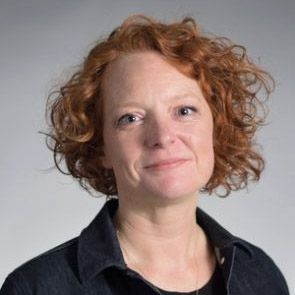Rachael Buchanan
Knight Science Journalism Fellow, ’14-15

Rachael Buchanan is the Medical Producer for BBC News. She has been a science and health journalist for the BBC for 14 years, producing pieces about science and medicine for TV, radio, and the web.
What is the one story you would like to be covering if you weren’t a KSJ Fellow this year?
“How do you feel about coming to Guinea with me?” That was the question posed by my colleague, BBC health correspondent Tulip Mazumdar, just a few weeks before I was due to leave the UK for my Knight Science Journalism fellowship here at MIT. Whilst still in its early days, the Ebola outbreak in West Africa was already an important global health story. It would have been an incredible, challenging last job before my year away in academia. I was hugely tempted, until I imagined the faces of the immigration officers at Boston airport when they opened up my passport and saw a fresh Guinea stamp inside.
At the time we had no idea just how much momentum this outbreak would gain and how appalling a toll it would exact: more than eight thousand dead and twenty one thousand infected as I am writing in January 2015. It has developed into the world’s worst Ebola outbreak, has become a staple story for several of my BBC colleagues, and would no doubt have featured prominently in my own work schedule were I still there.
For most journalists, the day-to-day reporting you do is hopefully (if not always) interesting and of some importance, but rarely is it on an issue of such global significance. So I am absent for one of the most important stories of the last few years in my area of specialism. When I watch and read the Ebola outbreak coverage, I confess to feeling the tug of my profession a little, but I am also getting a unique opportunity to watch that story unfold as a news consumer not a news producer. That will no doubt inform my work when I return in the summer.
“The explosion of social media platforms and digital story telling tools has complicated questions of who is a journalist and what journalism is.”
How important is a compelling human narrative when reporting on a complicated scientific issue or a new piece of research? Do you feel narratives like this help or impede public understanding of complicated scientific issues and new research?
Humans are storytellers by nature — we find evidence of this compulsion in societies throughout history. Even in prehistoric cave paintings there are threads of human drama and narrative to be seen. Sharing information in a narrative form helps communicate difficult subjects or complex information. The act of framing something within human experience, rather than leaving it as abstract facts, helps people relate to that message and see its relevance to their lives.
This approach is particularly valuable when communicating science and health. The BBC is a generalist news organization, and science often scares people off. If you can frame your story in a context that people can relate to — show them why they should care, that this discovery or health message has some relevance to their lives — the public will be more engaged.
How does the proliferation of social platforms — Twitter, Tumblr, Facebook — and digital storytelling tools — embedded video, slideshows, podcasts — change the way you conceive of your work as a journalist?
In less than a decade, journalism has undergone a huge upheaval. The explosion of social media platforms and digital story telling tools has complicated questions of who is a journalist and what journalism is.
Putting aside the issues this raises about which voices are the ones to trust, the impact of those technical and creative innovations has been a liberation of the way we tell our stories. Gone are the days of media silos and tightly constrained formats. There is more synergy between media platforms in a story’s coverage now. We are more imaginative and daring in the visual devices and structure of TV packages, often using complex 3D graphics and a more narrative approach in our news pieces.
Online, the audience has a much richer experience, with traditional text articles complemented by additional media such as video clips, slide shows, or interactive graphics, which all broaden the storytelling. And the way people view our stories is also changing: a growing number access news via tablets or smartphones. This in itself has a large influence on the way we design our content, with graphics and page layouts being built to work just as well on a smartphone as on a PC.
Suggested Links
MIT Knight Science Journalism Program website
Watch: a BBC video on vaccinations in Laos produced by Buchanan
Story prepared by MIT SHASS Communications
Editorial team: Emily Hiestand and Daniel Pritchard